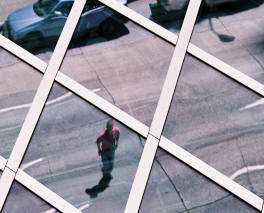Spring Street Mirrored in Library Glass
 |
I began using the new Central Library shortly
after its
opening in the Summer of 2004. I use the library's
marvelous open shelving. I'm easily seduced into wandering the
rows of book-spiral sections from 900 down to 500 (my favorite
mathematics and logic haunt). Sometimes I also end up with
the books I started out to find.
When the new building was opened, most of
the fuss was about the
architecture and the structure. I was more concerned about the
collection and access to materials. After learning my way around,
I became satisfied that the collection is in good hands and being
expanded about as well as can be expected in these times.
Also, the library is, despite its
unusual architecture, a hospitable place.
This became quite clear to me when I
finally took a
tour of the place,
tagging along with the attendees at
EPIC2005.
The architecture tour provided great insight into the attention given to
the creation of library spaces, with the collection and services open
and available to library patrons. Listening to the guide, I began
to appreciate what was accomplished by the the new structure:
-
The collection, now approaching one
million books (and approximately two million items of all kinds), has capacity for about 1.4 million
books without adding any
shelving.
-
80% of all materials are on open
shelves, with only 20% in stacks.
-
Even rare reference materials are on
open shelves although in supervised areas (material that requires gloves in
order to be handled, for example).
-
The return system sorts books
automatically, with books distributed into bins that are then used
for manual re-shelving.
-
There is one-stop shopping at the
main desk where you can ask for everything you want and it will be
delivered to you at that desk. The staff at the main desk are
in radio contact with librarians everywhere else in the building.
-
You can also go to the books, browse,
study, wander the shelves, and consult the librarians in the particular areas.
-
Even books put on hold can simply be
walked up to and collected where they are waiting for the patron who
requested them.
-
Usage of the library doubled, with a
great increase in library cards, after opening of the new library.
-
There are public computers
practically everywhere in the library, including printers, fiche
viewers, scanners, and other tools. Many of the
reading tables provide power outlets and RJ-45 Ethernet connections for laptops. There is WiFi
for patron's computers as well as a wired network of the public computers.
-
There are sprinklers on all floors
and over the book spiral. Sprinklers operate in sections in
order to isolate fires and avoid unnecessary damage. After a
fire (or other trigger for sprinkler release), the wet books are frozen
for preservation and later restoration.
-
There is a form of black flocking
over some of the steel pillars inside the building. We were
told that it is a heat-retarding insulation used for fire
protection. In other places, the steel beams appear to
be painted. That is another special material that expands and
foams in response to heat, also providing a heat-retardant for the
steel girders. I was puzzled why one would worry about
protecting steel from fire, and then I realized that it is to
preserve the integrity of the building for as long as possible in
case of a catastrophic fire.
-
There is a system-wide on-line
catalog that will let you know about any book, what branch holds it,
where, and whether it is in the library or circulating and how many
holds are waiting for it.
-
Holds can be requested on-line and
the book delivered to a branch of your choice.
-
The system provides e-mail notices of
book availability and books approaching their due date. You
can renew a book on-line (unless there is a hold on it).
-
There are now
RSS feeds on your own
hold notices and due notices. You can create personal queries
that have RSS feeds. You can e-mail library query results to
yourself, something I have taken advantage of.
|
|
I saw my first issue of Communications of the ACM in the summer
of 1961. It was on the shelves of the Seattle Public Library in the
then-new main library (a building that was demolished for construction of
the new central library on the same site). I saw the January 1961 issue
and it was like I had gone to heaven. I had heard of the ACM around the
University of Washington campus (where I was often found plugging away
in the computer center in the wee hours). Someone showed me an article on
code generation in compilers, but I had not seen Algol 60. I immediately
went back through the 1960 issues -- what a treasure trove 1960 was --
and also joined the ACM. I managed to go down to LA for the 1961 ACM
Conference and there also arrange a transfer to New York City and an
advanced software development team in Sperry Univac. I loved the
algorithms and the articles and almost everything that my membership
brought me. In those days Journal of the ACM and the
newly-initiated Computing Reviews was included and I admired that and
digested some of it too, along with the newly-initiated Computing
Reviews. I was 22.
|
|

